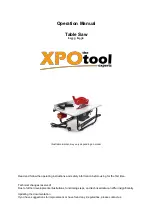
CHAIN MAINTENANCE
CAUTION: Remove the battery pack and make sure the chain has
stopped before you do any work on the saw.
For smooth and fast cutting, chain needs to be maintained properly.
The chain requires sharpening when the wood chips are small and
powdery, the chain must be forced through the wood during cutting,
or the chain cuts to one side. During maintenance of your chain
remember:
-
Improper filing angle of the side plate can increase the risk
of severe kickback.
-
Raker (depth gauge) clearance.
-
Too low increases the potential for kickback.
-
Not low enough decreases cutting ability.
-
If cutter teeth have hit hard objects such as nails and
stones, or have been abraded by mud or sand on the
wood, have service dealer sharpen chain.
NOTE: Inspect the drive sprocket for wear or damage when
replacing the chain. If signs of wear or damage are present in the
areas indicated, have the drive sprocket replaced by a qualified
individual.
HOW TO SHARPEN THE CUTTERS
Be careful to file all cutters to the specified angles and to the same
length, as fast cutting can be obtained only when all cutters are
uniform.
Wear gloves for
protection.
Properly tension
the chain prior to
sharpening. Refer
to
“
Chain Tension
Section
”
earlier in
this manual. Do all
of your filing at the
midpoint of the
bar.
Use a 5/32 in.
diameter round file
and holder.
Keep the file level
with the top plate
of the tooth. Do
not let the file dip
or rock. Using light
but firm pressure,
stroke towards the
front corner of the
tooth.
CHAIN MAINTENANCE
Lift file away from the steel on each return stroke.
Put a few firm strokes on every tooth. File all left hand cutters in one
direction. Then move to the other side and file the right hand cutters
in the opposite direction. Occasionally remove filing from the file with
a wire brush.
WARNING:
Improper chain sharpening increases the potential of
kickback.
WARNING:
Failure to replace or repair damaged chain can cause
serious injury.
WARNING:
The saw chain is very sharp, always wear protective
gloves when performing maintenance to the chain.
TOP PLATE FILING ANGLE
Correct 30 degrees –
File holders are marked with guide marks to align
file properly to produce top plate angle.
Less than 30 degrees –
for cross cutting.
More than 30 degrees –
feathered edge dulls quickly.
SIDE PLATE ANGLE
Correct –
80
degrees produced automatically if correct diameter file is
used in file holder.
Hook –
“
Grabs
”
and dulls quickly. Increases potential of kickback.
Results from using a file with a diameter too small, or file held to low.
Backward Slope –
Needs too much feed pressure, causes excessive
wear to bar and chain. Results from using a file with a diameter too
large, or file held too high.
DEPTH GAUGE CLEARANCE
The depth gauge should be maintained at a clearance of .025 in. (0.6
mm). Use a depth gauge tool for checking the depth gauge clearances.
Every time the chain is filed, check the depth gauge clearance
Use a flat file and a depth gauge jointer to lower all gauges uniformly.
Depth gauge jointers are available in .020 in. to .035 in. (0.5 mm to 0.9
mm). Use a .025 in. (0.6 mm) depth gauge jointer. After lowering each
depth gauge, restore original shape by rounding the front. Be careful not to
damage adjoining drive links with the edge of the file.
Depth gauges must be adjusted with the flat file in the same direction the
adjoining cutter was filed with the round file. Use care not to contact cutter
face with flat file when adjusting depth gauges.
10
LPS40820
-
1
































